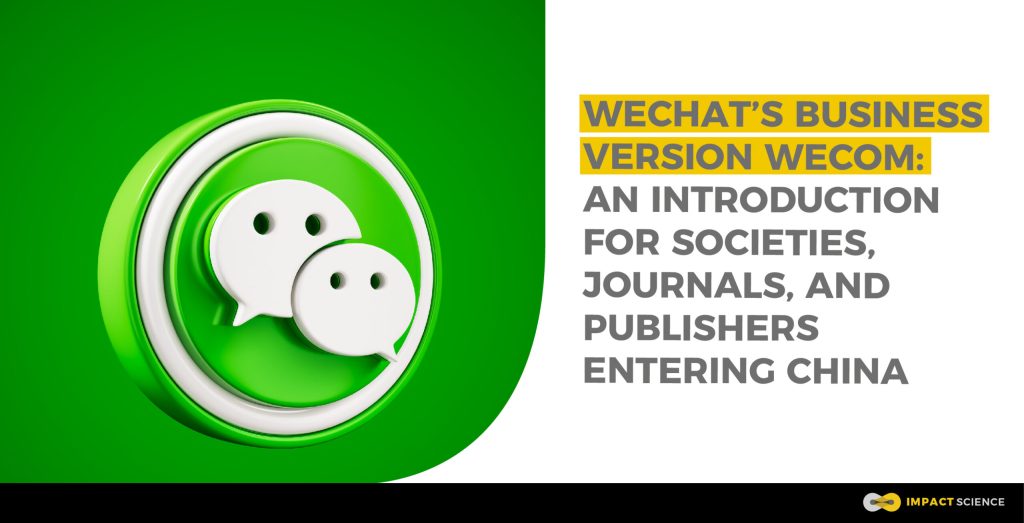China will be one of the most active markets for the scientific research industry in the next five years, according to the Report on Market Foresight Analysis and Future Investment Strategy of China’s Scientific Research Industry (2022-2027). Consequently, many international publishers and societies are making efforts to expand their presence in China. However, it is not easy to achieve this goal because of unique digital behaviors and communication cultural practices among Chinese academia, such as “Guanxi”1 and “Quanzi”2. A large amount of day-to-day digital communication and information-sharing takes place on the WeChat social media platform, which had over 10 billion active users in 2022. One of the most common ways for Chinese researchers to access research-related information is to read the latest WeChat articles “pushed” by the WeChat official accounts they subscribe to or those recommended by their WeChat friends.
See also: WeChat for Academia: Understanding Subscription and Service Accounts
Chinese enterprises are changing quickly, stimulating the systematic digitalization of different industries, including the research publishing industry. For Western publishers and journals, knowing how their Chinese counterparts manage daily operations can be helpful to understand the Chinese market better. Moreover, it is useful for international publishers and societies to learn about the unique Chinese digital ecosystem from different angles, including the perspectives of consumers, employees and partners.
What is WeCom?
WeChat is not merely a social media platform. Its provider, Tencent, has established a digital empire that includes almost every daily service for individuals and organizations. Among these, WeCom (WeChat work) is a software designed to provide organizational communication for work purposes. Before the launch of WeCom, many employees complained bout lack of work-life balance because the managers kept sending them WeChat messages for work whereas they considered WeChat to be their personal social media.
Because WeCom is limited to business purposes, it has far fewer active users than WeChat, but still a very impressive number: more than 1.8 billion in 2022. Every hour, 1.15 million employees of various businesses interact 140 million times with other users on WeCom. Currently, the number of WeCom service providers (i.e., companies with WeCom accounts) has reached 120,000, among which the number of service providers rated as “excellent” has exceeded 6,000. WeCom service providers cover 97 industries, with 1,232 unique interfaces that seamlessly integrate WeCom and 1,900 third-party applications.
See also: WeChat for Academia: Mini-Programs and How to Use Them
Why is WeCom better than WeChat for businesses?
With regard to functions, WeCom provides the same communication features as WeChat but with more applications to support business-related automation. For example, WeChat allows an individual account to create a group with up to 500 members, while WeCom allows up to 10,000 group members for an organizational group and up to 2000 members for other groups. The organization can use WeCom to invite customers, vendors, suppliers, and partners to join its WeCom groups for more accessible communication. Similarly, a WeChat account can add up to 5000 “friends,” but an individual WeCom account can add up to 50,000 “friends.” Besides, a WeChat account can send up to 200 messages to friends, while a WeCom account has no limit for bulk messages. Another feature that makes it more business-friendly than WeChat is that WeCom accounts can share the information of their “friends” (e.g., customers) with other WeCom members, which makes for seamless work handover or workflow support. These powerful features of WeCom can be beneficial for business networking as well as operations management. Additionally, WeCom provides various APIs to allow organizations to access and integrate WeCom with other applications, including applications of the WeChat ecosystem and third-party partners.
See also: WeChat for Academia: 5 Western Publishers Who Have Created An Online Presence in China
Many leading publishers and societies have started using WeChat for brand promotion and market expansion, but not many have used WeCom, perhaps because WeCom has been designed for enterprise management rather than marketing. However, as the WeCom product team leader Tieming Huang said, “The most exciting part is not the numbers, but the changes in the way the enterprises operate behind the numbers, which makes WeCom more determined to connect and create value.” As larger organizations like publishers set up local offices in China, WeCom may prove valuable in streamlining communications and operations.
Footnote:
1 Guanxi refers to a cultural characteristic and a system of social networks and influential relationships that can benefit business and other dealings. Although networking and Guanxi are similar regarding their linguistic meaning, they are still different. Guanxi has specific implications for interpersonal and inter-organizational behaviors in Chinese society.
2 Quanzi and social circle have similar linguistic meanings but are contextually different. From a research perspective, Quanzi is a unique feature of Chinese society and refers to a “differential pattern”. The starting point of Quanzi in Chinese society is blood and geographical relationship. Regarding the trust structure of Quanzi, it is mainly a trust relationship with a closed network with a mixture of work relationships, emotional relationships, and identity relationships.









